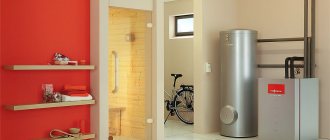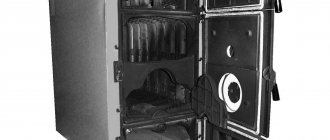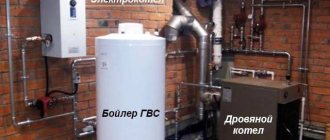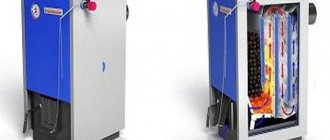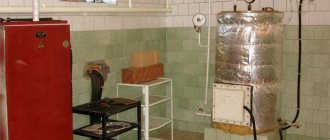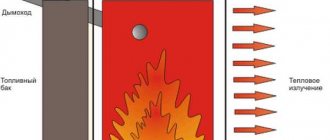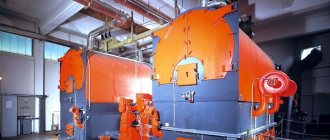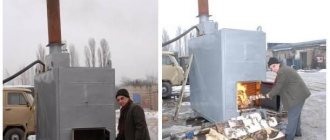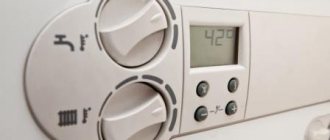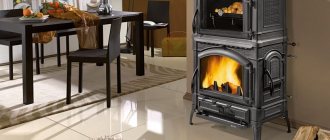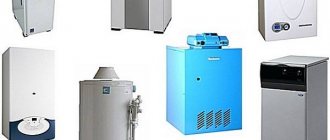General information
Due to the high cost of diesel fuel and electricity, as well as additional costs for connecting gas equipment, in many cases the choice is made towards a solid fuel boiler. As a result, you get a heating system whose operation is not affected by the presence or absence of external energy sources. As a rule, most devices of this type do not require electrical energy, or consume it in very small quantities.
Most often, solid fuel boilers are equipped with individual heating systems in remote areas experiencing serious difficulties with the supply of main gas. There are entire areas of our country where wood boilers are used as the main heating unit.
Basic information about solid fuel units
The high price of diesel fuel and electricity, the cost of connecting gas equipment emphasize the advisability of the decision to purchase a boiler operating on solid fuel. Based on it, it is possible to create a heating system that is independent of external energy sources, since most units of this class can operate without electricity or with minimal electricity consumption.
Solid fuel boilers are used as central units of an autonomous heating system in areas where there are problems with the supply of main gas. And in some settlements, of which there are quite a few in Russia, a wood-burning boiler is absolutely irreplaceable.
What does it consist of?
Diagram of a solid fuel apparatus
To understand how units of this class function, let's look at the design of a solid fuel boiler, which includes the following parts:
- The firebox is the so-called fuel combustion chamber and at the same time a heat exchanger. The design of the firebox includes: a portal for fuel supply, an area for removing volatile combustion products, a grate, containers for collecting ash and openings for air supply. During the combustion of solid fuel, the walls of the firebox heat up, and the water around the firebox in the water jacket of the unit heats up.
Firebox
- Water jacket . As a rule, in the firebox of a wood-burning boiler there are double walls, between which there is a coolant (hereinafter simply water) - this is the water jacket. When the fuel in the firebox begins to burn, the water in the water jacket heats up, resulting in heat flows that raise hot water to the top of the jacket. From this part of the boiler, hot water enters the heating pipe. Having passed through the entire heating system and given off heat to the room, the already cooled water returns back to the water jacket through the lower pipe. In order to speed up the movement of water throughout the system, some solid fuel boilers are equipped with special heating circulation pumps. But still, most models are designed for open heating systems (that is, for those systems where water circulation is carried out not using pumps, but by gravity). This is due to the fact that gravity systems are simple, reliable, economical and independent. They can be used even in areas where there are no signs of civilization.
Traditional unit running on solid fuel
- Carbon monoxide removal system . Due to the combustion of solid fuel, a large amount of smoke is generated in the unit itself, so a chimney is a mandatory component of such devices. The smoke is removed using heat-insulated pipes leading from the boiler to the street.
Chimney installation diagrams
Note! Some models are also equipped with forced ventilation units.
Design of a solid fuel unit with forced ventilation
- Temperature control and regulation system . It is no secret that any combustion is simply impossible without air supply. And, it should also be noted that the intensity of combustion depends on the intensity of air supply to the firebox. And the design of solid fuel boilers involves regulating the air supply using mechanical dampers and dampers. This control system is very simple and reliable - the damper is tightly connected to a special regulator. When the temperature rises excessively, the walls of the regulator expand and the damper lowers, thereby reducing the air supply to the firebox. When the regulator cools down, the reverse process occurs - the damper rises, thereby increasing the air supply and, as a result, the combustion intensity. Of course, this method may seem very primitive and outdated. However, it is also the most efficient, which is why it is used in many models of solid fuel heating boilers. In addition, it still has no competitors, since the operation of such a mechanism does not require electricity, which costs a lot of money.
Classifications
A modern heating scheme with a solid fuel boiler can include both the simplest single-circuit devices and the most powerful, high-performance and multifunctional units. Let's look at what classifications solid fuel boilers are divided into.
According to the material of manufacture:
- Steel units . Cheaper than their cast iron counterparts, easier to maintain and much easier to clean with your own hands. But they are very demanding on the temperature in the return pipeline of the heating system (at least +60°C). Therefore, they need to install special valves that maintain the required return temperature (that is, hot water from the supply pipeline is mixed into the return pipeline).
Steel model Logano S121
- Cast iron units are durable, but they are more difficult to maintain. Solid fuel boilers made of cast iron are recommended to be purchased in cases where they are expected to be used continuously. But buying a super reliable cast iron unit only for emergencies does not make sense. A cheaper steel boiler can handle this quite well.
Cast iron model SIME SOLIDA 4
By type of fuel used:
- Firewood, peat, woodworking waste, their derivatives in the form of special briquettes;
Logs
- Coal;
Coal
- Pellets (are granules formed as a result of processing wood, resin, pine needles and other organic materials);
Pellets
- Today there are also models that operate on absolutely all types of solid fuel.
By heat transfer method:
- Air;
- Steam;
- Water (the most popular).
According to the principle of fuel combustion:
- Traditional (we think there is no need to explain anything here).
- Long burning - the latest innovation in heating technology. Long-burning solid fuel boilers are a vertical, elongated combustion chamber, around which there is a container with water. Combustion in such a chamber occurs not from bottom to top, but from top to bottom (this process can be compared to the burning of a candle). Thanks to this system, complete combustion of the fuel is achieved, the burning time of one bookmark increases (up to 7 days), a stable and high coolant temperature and decent efficiency.
Long burning apparatus Stopuva 7
For uninterrupted and safe operation of such units, they are equipped with a fan for emergency extinguishing, a safety valve and a heating circulation pump.
Attention! Long-burning boilers are automated and therefore require electricity. And, by the way, the instructions on how to operate these devices are quite simple, and even a child can figure it out.
- Pellet - that is, operating on special pellets. They actually consist of the boiler itself, an automatic pellet supply system and a bunker. The electronic control system checks the presence of fuel in the combustion chamber, and if it is not there, it turns on the mechanism for feeding pellets from the hopper. Quite convenient, but again a volatile solution.
Nice pellet model
- Pyrolysis (gas generating) The uniqueness of this type of solid fuel boilers lies in the fact that in addition to the combustion energy of solid fuel, they also use the heat release of gases that are formed during the combustion of solid fuel. As a result, much more thermal energy is generated from a minimum volume of fuel, which means the efficiency of the unit increases and its environmental performance improves.
Pyrolysis apparatus
Water jacket
The principle of operation of a solid fuel boiler implies the presence of double walls in its firebox: in the interval between them they are filled with coolant. This design is called a water jacket. As the fuel burns, the liquid in the water jacket heats up. This leads to the appearance of heat flows that lift the hot coolant to the upper part of the container. From here, hot water flows into the heat pipe. After the liquid passes through the entire heating circuit and gives off heat to the home, it returns back in a cooled state. For these purposes it has a lower pipe.
To speed up the circulation of water inside the heating system, special pumps are installed on some solid fuel boilers. However, most models are produced for open heating systems. This refers to schemes where the coolant moves not due to a running pump, but due to a slight slope of the pipeline. This is explained by the simplicity, reliability and efficiency of inertial systems. In addition, they are completely independent of the availability of electrical energy. Thanks to this, they can be used in remote areas deprived of the benefits of civilization.
Temperature control and regulation
As you know, a prerequisite for the combustion process is air supply. Moreover, the burning rate directly depends on the intensity of this supply. This principle is used in the design of solid fuel boilers, where there are mechanical dampers and dampers to regulate the air flow.
This design of a solid fuel heating boiler is characterized by simplicity and reliability: the damper is firmly attached to a special regulator. If the temperature rises excessively, this provokes expansion of the walls of the regulator and subsequent lowering of the damper. As a result, the intensity of oxygen supply into the combustion chamber decreases. The process of cooling the regulator activates the reverse process of raising the damper: air is able to flow in a larger volume, thereby increasing the intensity of combustion.
At first glance, it may seem that, given the operating principle of a long-burning solid fuel boiler, such a scheme for controlling the combustion process is too primitive and archaic. However, it is simplicity that is the key to its effectiveness and reliability. This explains the widespread use of slide control in most models of solid fuel heating boilers. Strictly speaking, this approach still does not experience much competition, because in this case, expensive electricity is not required.
Classic models
Such options are the most in demand; they are characterized by low cost and simple design, and are called direct combustion boilers.
There are two types of classic boilers.
The operation of structures of the first type is based on natural traction
, the second - on
forced air circulation
.
Solid fuel non-volatile boilers are designed quite primitively.
Air is supplied from the room through a damper. To regulate the air supply, a special thermostat is installed that responds to the temperature in the so-called boiler jacket. During the combustion of fuel, gases are formed that pass through the heat exchanger pipes. Water circulates around the pipes and is heated by the release of heat from combustion products. The latter make 2-3 passes through the pipeline, after which they are removed from the furnace using a chimney connected to it. The efficiency of such boilers depends on the specific type of design and volume of fuel used and often does not exceed 70%.
Models with forced air injection are considered more efficient.
As can be seen in the diagram of solid fuel boilers of this type, their design is in many ways similar to non-volatile modifications. But the main difference is the installed blower fan. Forced air supply makes the combustion process more stable and efficient, as a result of which the efficiency increases to 75%.
Types of solid fuel boilers
The operating principle of solid fuel boilers allows them to be part of various modern schemes. We are talking about both the simplest single-circuit devices and the most powerful multifunctional units with high performance. There are several ways to classify solid fuel equipment.
According to the material of manufacture:
- Of steel . The cost of steel appliances is lower than that of cast iron. In addition, they are easier to maintain: cleaning takes place without any problems. One of the disadvantages is the sensitivity of the models to the temperature in the return pipe: it must be at least +60 degrees. This involves the use of special valves to maintain the required temperature by mixing hot water from the supply pipe into the return.
- Made of cast iron . They are characterized by higher durability, but require complex maintenance. The use of cast iron solid fuel boilers is recommended in case of continuous use. Purchasing an ultra-reliable cast iron unit only for emergencies is not a practical solution. Cheaper steel models can cope with such tasks.
Principle of operation
The boiler runs on solid fuel, usually wood, peat, lumber waste, special wood briquettes, coal and pellets (pellets made from crushed wood, resin, pine needles, etc.). Particularly popular are universal-type devices that can consume almost all types of solid fuel.
According to the method of heat transfer, boilers are:
- Air.
- Steam.
- Water (found most often).
According to the principle of fuel combustion:
- Traditional . They work on wood and coal. The operating principle is the same as that of a conventional wood stove.
- Long burning . Innovative development in the field of heating equipment. Long-burning solid fuel boilers have the form of an elongated combustion chamber surrounded on all sides by a water jacket. When burning, the flame spreads not from bottom to top, but from top to bottom, reminiscent in this respect of the process of burning a candle. The operating principle of a long-burning boiler allows complete combustion of fuel to be achieved. At the same time, the combustion interval of one load of fuel increases (up to 7 days). A long-burning boiler operates, as a rule, at a consistently high coolant temperature, which increases its efficiency by an order of magnitude. The uninterrupted and safe operation of such models is achieved by incorporating fans for emergency extinguishing, a safety valve and a circulation pump into the design.
- Pellet . Special pellets are used as fuel here. Such boilers are additionally equipped with an automatic pellet supply system and a fuel storage bunker. Thanks to electronic sensors, the presence of fuel inside the firebox is monitored. To operate such a system, a stable electrical supply is required.
- Pyrolysis . Unique equipment where, along with the energy from the combustion of solid fuel, the heat release of gases is also used. This makes it possible to convert a small amount of fuel into a significant portion of thermal energy. As a result, an increase in boiler efficiency and a reduction in harmful emissions is achieved.
The operating principle of long-burning solid fuel boilers makes it possible to use automation. Operating units of this type is so simple that a child can handle it.
Design and principle of operation
- Like all solid fuel units, a wood-burning water boiler has a combustion chamber into which firewood is added through the top door. The only difference is the very spacious firebox.
- A grate will be placed in it.
- Under the grate there is a special chamber where ash from burnt wood falls. The chamber has a door through which ash and coals are cleaned. By the way, many manufacturers install a retractable tray; it makes the cleaning process easier.
- A chimney must be installed in the upper part.
Internal structure
And now the distinctive design features.
- A heat exchanger, usually made of cast iron, is installed inside the combustion chamber. This is a hollow cast structure, inside which heated air moves, not hot water. It is with the help of hot air that water is heated for household needs.
- And the main part of the boiler is the tank (reservoir). There are two options here - how the tank is located relative to the combustion chamber. It can be installed on the top or side. The first option is preferable because hot air always tends upward, which allows for an effective heat exchanger installation scheme.
- And, as an additional element of the device, this is a fan, which is not installed in all models. It supplies fresh air to the combustion chamber. By the way, it is installed on the side of the firebox.
The body of the water heating unit is made of metal (this is high-strength steel); thermal reflective screens are necessarily installed; they are placed on the internal surfaces of the body. They not only prevent the boiler walls from overheating, but also provide reliable protection against chemically aggressive substances and mechanical damage.
Principle of operation
The combustion chamber is most often made of cast iron plates. Some manufacturers offer boilers whose fireboxes are made of refractory bricks.
Attention! The design of the combustion chamber of this type of hot water boilers does not allow the use of solid fuel combustion technology by pyrolysis. There is simply no way to divide the firebox into two separate combustion chambers. And that's the problem.
Principle of operation
The operating principle of a wood-fired hot water boiler is based on the combustion of fuel, which transfers its thermal energy to a cast iron heat exchanger. It in turn transfers heat to the air that is inside it. The latter moves through the internal cavities and enters the continuation of the heat exchanger located inside the tank filled with cold water.
Passing through the heat exchanger in the tank, the air gives off its thermal energy to the water. This is how heating occurs. Cooled, it then returns to the heat exchanger located in the combustion chamber. And the cycle repeats. Everything is very simple and original. In addition, air heats up faster than water, which causes rapid heating of the water in the tank itself.
Hot water boiler
Let us add that part of the thermal energy enters the tank through the metal walls of the solid fuel hot water boiler itself. This is a plus that increases the efficiency rate. By the way,
- The efficiency of such installations is 80-85%. Not the highest level for solid fuel boilers. But it is for this water heating design that it is considered normal.
- In the tank, the water is heated to +95°C, at a pressure of 0.6 atm.
